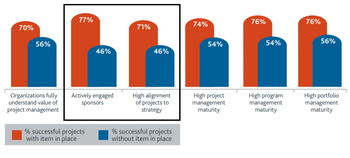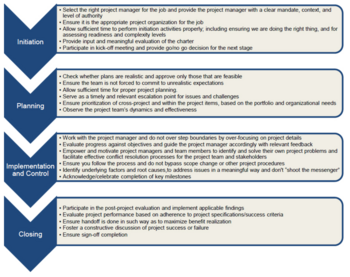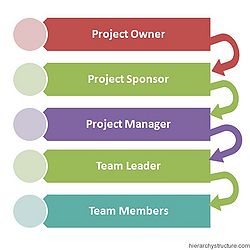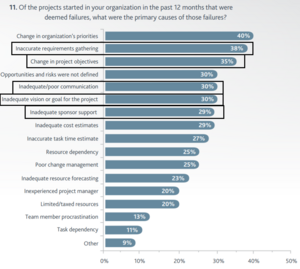Project sponsor
Developed by Vincent Oriot
This wiki-article is written in order to reflect on how important the role of Project Sponsor (also called executive sponsor) is in a project, and actually is the backbone for the entire project, and without whom the project would not be started. This role is often skipped or misdefined, which can explain why some projects are failing, or not doing as good as they should. To improve global understanding about Project sponsorship, we will present the role and definition of what is a Project Sponsor, what are his responsibilities throughout the project (focusing on the initiating phase), then describe the relationships with the other stakeholders of the project and then finish with some advice to avoid most common pitfalls.
Sponsors play an essential, if not vital, role in projects, and even though some people may disagree, every project needs a Project Sponsor. Sponsorship in a small business is, however, often significantly different from sponsorship in a large business or a corporation. Because the roles and responsibilities of a Sponsor and a Project Manager run parallel but are different from each other, it is important to know both what project sponsorship is and what it is not (this will be discussed later in the section "Relationship with the stakeholders"). Project Sponsorship is still a topic that requires formalization, better understanding and is at the moment still vague. A powerful quote supporting this insight was given by a senior project manager "I now understand that a project I recently sponsored was not nearly as successful as it could have been—partly due to my not having understood my role as a sponsor." [1] Despite the lack of formalization of the position in a project, we will rely on the information given by organisations linked to project management, such as the PMI (Project Management Institute)[2] and their conferences[3]. or their book Project Management Body of Knowledge (PMBoK) or the IPMA (International Project Management Association)[4]. As this topic is related to project management, we will also use the PRINCE2 as a reference. Managing stakeholder expectations for project success [5] Another reliable source of information that we will use, is the KPMG report published every year, that presents surveys and research about project management in general and sometimes about Project Sponsor. [6]
Contents |
Definition and Role of the Project Sponsor
Definition
A Project Sponsor is: " An individual (often a manager or executive) with overall accountability for the project." (definition is given during PMI Global Congress in London in 2015) [1] . This vision is stated again in The PRINCE2, where the term for Project Sponsor is Executive ref. There are many pressures to contend with, especially at the higher levels of management and multiple priorities and causes compete for scarce organizational resources, capacity, funding, and focus. A Project Sponsor is not a Project Manager nor the Project Owner (also called "benefit owner"). These three jobs have different tasks and responsibilities and for the good of the project, they should clearly be differentiated. The most common distinction is that the sponsor wants the project implemented and will pay for it and the owner is the person who will benefit from the realization of the project. The Project Manager is the one that will implement what the Project Sponsor has decided to do. More information will be given in the section "relation with other stakeholders". It can be mentioned that unlike a large business, in which a sponsor can be any one of a number of different individuals, in a small business, the sponsor is most often the business owner, but this remains an exception. In brief, it is the individual or group within the performing organization who provides the financial resources, in cash or in kind, for the project. [7] It needs to be clarified that the project sponsor is not the customer nor the client, but someone from the performing organization that understands the organization's business and the corporate strategy. Project Sponsors are often senior or former Project Managers, that have experience about project management and have a deep understanding of the project.
Role

The role of the Sponsor starts at the very origin of the project. They play a crucial role in the development of the initial scope and charter, and effective sponsors lead the project through the selection process until formal authorization. The first duty of the Project Sponsor is to define the project, identifying what the project must achieve. This requires a good understanding of how the organization operates and the corporate strategy. Once the project’s organizational goals are defined, the Sponsor must translate that vision into clearly understood deliverables for the Project Manager and team.[6] We put here the result of a survey from 2015 that shows that project with a highly engaged Project Sponsor succeed around 77% of the time while for the other it's only 46 %, the alignment of the project with the strategy has a huge impact as well, those tasks should be done by an effective Project Sponsor, but as his role is often misunderstood, these aspects are missing, resulting in the project failure. [8]. The Project Sponsor is the escalating path for the Project Manager to the top management and from that perspective his upper hierarchy.[7]
The next missions are independent of the stage of the project and must be carried out during its entire length.
✓ Help streamline communication and encourage quality requirements and estimates.
✓ Create a sense of trust, collaboration, and honesty.
✓ Clear role in problem escalation and resource issues.
✓ Means and sources to identify problems (i.e., schedule, cost, quality) before they are officially reported.
✓ Foster requirements and scope prioritization.
✓ Ensure timely change control and decision making; dependency identification mechanism.
✓ Allow for effective risk management process including requirements, project, and business risk considerations.
✓ Encourage record keeping and access to historical information, benchmarking, references, and application of lessons.
Responsibilities
A project sponsor is typically responsible for initiating, ensuring, approving, and establishing a series of key aspects in relation to the project, which can be summed up under categories of vision, governance, and value/benefits realization. The Sponsor must translate that vision into clearly understood deliverables for the Project Manager and team. The stakeholders might have different points of view and different interests in the project, so project sponsors must be the ones to secure buy-in from every stakeholder, in making everyone agree on the project characteristics, sometimes negotiating, but always putting forward how much a better place the world will be after the project is finished. The missions throughout the project are clarified in the picture on the right. Indeed, the span of the responsibilities of the Project Sponsor starts from the initiation of the project to its planning, through its implementation and control until its closing.

Responsibilities of the Project Sponsor include:[10]
– Selecting the project manager
– Establishing the project goals
– Leadership & direction of the overall project
– Guidance to the Project Manager
– Assistance for the PM with appraisal and reporting
– Selling the project to stakeholders
– Resolving risks and issues (where the PM cannot)
– Review and approval between project phases
– Approval of major changes
– Unblocking access to essential resources if necessary
Relationship with other Stakeholders

A stakeholder is an individual, group, or organization who may affect, be affected by, or perceive itself to be affected by a decision, activity, or outcome of a project. Stakeholders may be actively involved in the project or have interests that may be positively or negatively affected by the performance or completion of the project. Definition given in the book Project Management Body of Knowledge (PMBoK)[7].
The Sponsor is as project advocate. Effective sponsors must know how to convey the project vision to anybody who can influence the outcome. As mentioned before, the project sponsor is accountable for all the aspects of the project and at every step of the project progress, and because of that, he has to interact with all the stakeholders of the project (internal or external). For issues that are beyond the control of the project manager, the sponsor serves as an escalation path, an intermediate between the project manager and top management. Sponsors must act as liaisons to the organizational stakeholders, communicating how the project will integrate into their overarching strategy and goals. "The Sponsor versus the Project Manager" is a leitmotiv in project management, but it shouldn't be so, they have complementary tasks and should work hand by hand to carry the project until the end with the best results. The picture on the right explicit the relationship and the hierarchy between the different stakeholders. We will only focus on the three first and their respective responsibilities:
-the Project Owner, the one to whom the project will benefit
-the Project Sponsor, the one who is in charge of defining the project and its objectives
-the Project Manager, the one (with his team) that will actually realize the project.[12]
Good practices
It is a good idea to keep in mind the fact that there might be more than one project sponsor, depending on the size of the project for example. Most Sponsors do not devote enough time explaining how the project aligns with the overall strategy. By making the effort to draw a clear connection from project to strategy, Sponsors should provide team members with a sense of purpose, which serves as a major motivational tool. Even though there is no official certification about project management, some insight might be relevant to take into account, questions every project sponsor should ask himself:
› Being an effective Sponsor requires striking a delicate balance of involvement and trust in the project team.
› Project Sponsors must effectively communicate the organization’s vision, goals, and expectations to the team throughout the life cycle without crossing the line into micromanagement.
› The Sponsor and project manager need to agree from the beginning on their roles to ensure a harmonious and productive relationship.
› Along with supporting the project manager and team, the Sponsor must keep the organization apprised of the project’s progress and benefits, advocating for it at every turn.
› The Sponsor should cultivate a positive environment and constantly let people know what the project is and why it’s important to the rest of the organization.
Challenges/Pitfalls
The role of Project Sponsor is often not well defined in a project and some Project Sponsors are not even well aware of their role. It often happens that a project manager is not even aware of whom is the project sponsor. This issue arises from the fact that unlike project management, project sponsorship doesn't have an official organization, institute that defines methodologies, and approaches for the project sponsor.
Some people might think that the role of Project Sponsor interferes with the role of Project Manager, but if the tasks are well defined, then their work is complementary and they need each other to achieve the best result possible for their project. The Project Manager has success and performance criteria based on time and money [13] while the project sponsor has a global overview of the strategy of the company and focuses on different criteria.
Quite often, Project Sponsors have a day job, in addition to the Project Sponsor one. And because of their experience, that job might be quite demanding, preventing them from spending the right amount of time on the project, they for example have to manage corporate strategy and departmental plans, commercials and contracts, financials and budgets, people and technical resources, administration and logistics, and last but not least office politics.
One common criticism is that they are never seen throughout the project but only appear at the end, "the waving of the checkered flag/during the victory lap", to get all the merit and the fame.
The difficulty for the Project Sponsor is to be involved enough to fulfill its tasks, but not too omnipresent otherwise he will prevent the Project Manager to do his mission properly. He has to find a balance between involvement and autonomy.

We will analyze the result of a survey submitted to companies that handle projects and have project managers or teams, about the main reasons for project failure.[8]. We are not saying that all issues depend on the Project Sponsor to be solved, but with an effective Project Sponsor, these can be reduced or even suppressed. One can notice that these failures correspond most of the time to the responsibilities and role of a project Sponsor (see above). These figures emphasize the fact that even nowadays, Project Sponsorship is misunderstood or misimplemented in most of the projects. There is still a long way to go when it comes to project sponsorship and its correct understanding and implementation within projects. It is becoming a growing concern and we can expect an institution being created soon.
References
Some websites will be used as references, but to prove their veracity and relevance, the dates of the consultation will be listed and the websites will only be among the certificated ones for this topic. Some of them can be mentioned to provide further reading or information, for example: -The PMI Website -The PMBoK -The KPMG survey about project management
- ↑ 1.0 1.1 Project sponsorship: senior management's role in the successful outcome of projects. Schibi, O. & Lee, C. Project Management Institute. Paper presented at PMI® Global Congress 2015. EMEA, London, England. Newtown Square.
- ↑ PMI website.
- ↑ PMI certification.
- ↑ International Project Management Association.
- ↑ Schibi, O. (2013). Managing stakeholder expectations for project success: A knowledge integration framework and value-focused approach. Lauderdale, FL: J. Ross Publishing.
- ↑ 6.0 6.1 6.2 KPMG report of 2017 about Project Management
- ↑ 7.0 7.1 7.2 Project Management Body of Knowledge (PMBoK).
- ↑ 8.0 8.1 8.2 Capturing the Value of project management, page 9 Feb 2015
- ↑ The Four Major Phases of an Engineering Project http://www.theprojectmanagementblueprint.com/?p=392
- ↑ Looking for your sponsor?: the PRINCE2™ project board approach to senior management engagement
- ↑ Project Management Hierarchy https://www.hierarchystructure.com/project-management-hierarchy/
- ↑ Schibi, O. & Lee, C. (2015). Effective PM (Project Management) and BA (Business Analyst) role collaboration: Delivering business value through projects and programs successfully. Fort Lauderdale, FL: J. Ross Publishing.
- ↑ Project Management Triangle